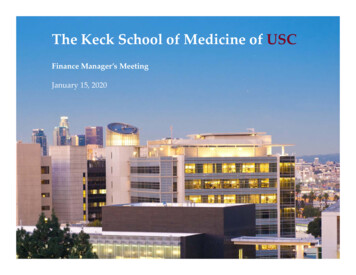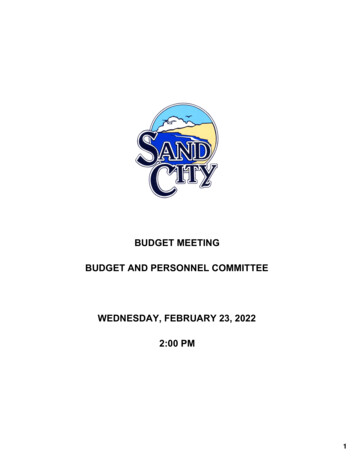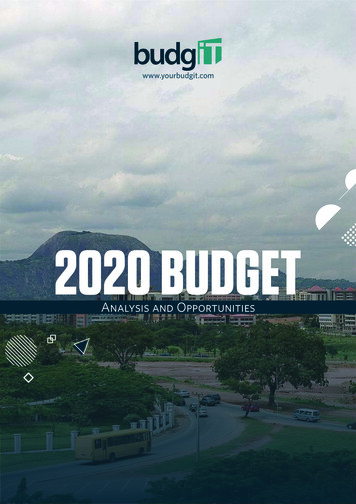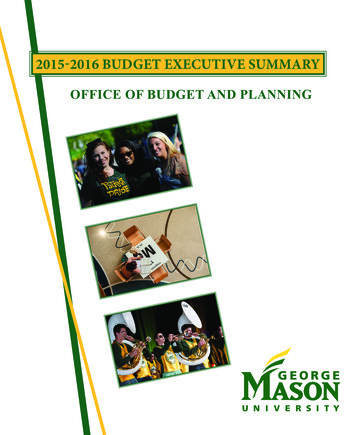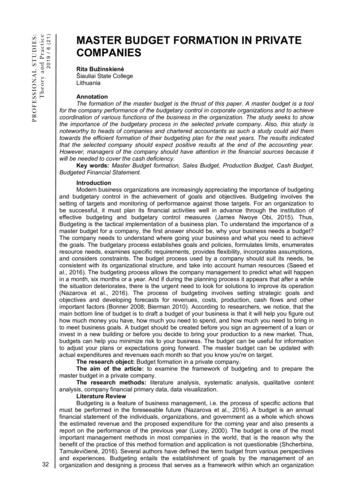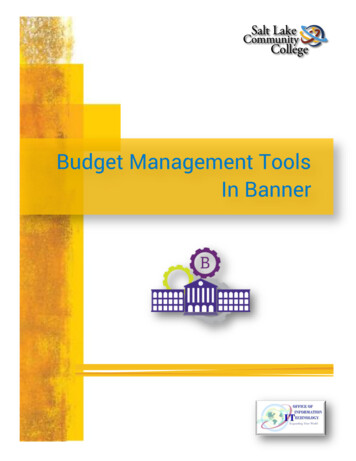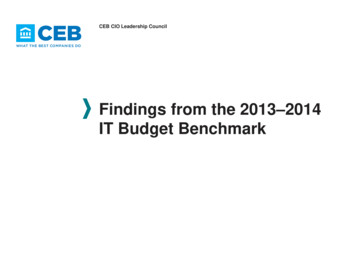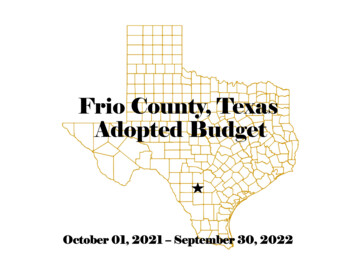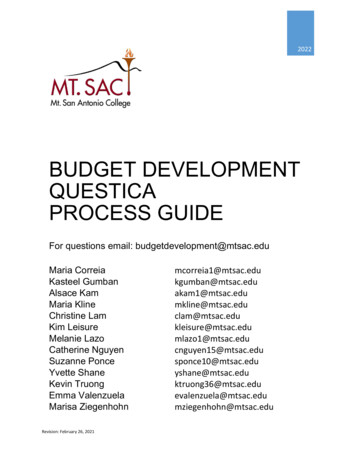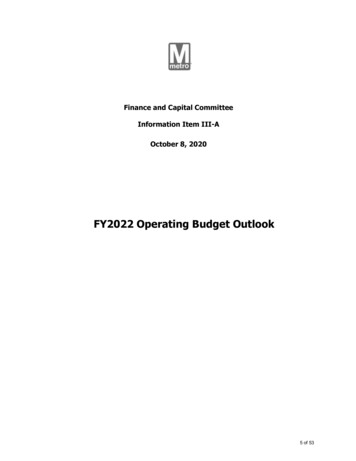
Transcription
A PE PLE’SBUDGETHOW THE PUBLICWOULD RAISE TAXESBEN GLOVERCHARLES SEAFORDSEPTEMBER 2020
Open Access. Some rights reserved.Open Access. Some rights reserved. As thepublisher of this work, Demos wants to encouragethe circulation of our work as widely as possiblewhile retaining the copyright. We therefore have anopen access policy which enables anyone to accessour content online without charge. Anyone candownload, save, perform or distribute thiswork in any format, including translation, withoutwritten permission. This is subject to the termsof the Creative Commons By Share Alike licence.The main conditions are: Demos and the author(s) are credited includingour web address www.demos.co.uk If you use our work, you share the resultsunder a similar licenceA full copy of the licence can be found egalcodeYou are welcome to ask for permission to use thiswork for purposes other than those covered by thelicence. Demos gratefully acknowledges the workof Creative Commons in inspiring our approach tocopyright. To find out more go towww.creativecommons.orgStandard Life Foundation funds research, policywork and campaigning activities to tackle financialproblems and improve living standards for people onlow-to-middle incomes in the UK. It is an independentcharitable foundation registered in ScotlandPublished by September 2020 Demos. Some rights reserved.15 Whitehall, London, SW1A 2DDT: 020 3878 3955hello@demos.co.ukwww.demos.co.uk
CONTENTSACKNOWLEDGEMENTSPAGE 4KEY FINDINGSPAGE 5EXECUTIVE SUMMARYPAGE 7INTRODUCTIONPAGE 13CHAPTER 1AN AFFORDABLE TAX SYSTEM FOR EVERYONEPAGE 15CHAPTER 2THE SAME TAX SYSTEM FOR EVERYONEPAGE 34CHAPTER 3A TAX SYSTEM THAT RESPECTS EVERYONE’S RIGHTSPAGE 40CHAPTER 4A TRANSPARENT TAX SYSTEM THAT NO-ONE CAN AVOIDPAGE 51CHAPTER 5SCOTLAND AND WALES SPECIFIC ISSUESPAGE 55CHAPTER 6RECOMMENDATIONSPAGE 62ANNEX 1ATTITUDES TO ENVIRONMENTAL TAXES AND TAXES ON GAMBLINGPAGE 64ANNEX 2SUMMARY OF QUALITATIVE FINDINGS BY TYPEPAGE 68ANNEX 3POLL FINDINGSPAGE 70ANNEX 4METHODOLOGYPAGE 713
ACKNOWLEDGEMENTSWe would first like to thank the Standard Life Foundationfor their generous support of this project. In particular, wewould like to thank Mubin Haq for his invaluable advice andenthusiastic engagement throughout the project.We would like to thank the academics, researchers andthinkers with whom we spoke and without whose work thisproject would have been much more difficult. In particular, wewould like to thank Arun Advani, Adam Corlett, David Gauke,Helen Miller, Robert Palmer, Tim Pitt, Andy Summers, EdwardTroup and George Turner.We would also like to thank officials across HM Treasury, theScottish Government and the Welsh Government, as well asTony Verran for such positive engagement throughout theproject.At Demos we would like to thank Polly Mackenzie and HarryCarr for contributing to the report’s thinking and to Asli Atayfor her sterling help with the polling analysis. We would liketo thank Josh Tapper, Maeve Thompson, Toby O’Brien andJames Sweetland for their help with the final stages of theproject. Finally, we’re extremely grateful to Josh Smith for hisextremely valuable help with the development of the DemosTax Calculator.We would also like to thank our three project partners:Howard Reed for undertaking the economic modelling thatunderpins this project, Andrius Bartulis and his colleagues atCre8ion for their development of the Demos Tax Calculatorsoftware and to the whole team at Hopkins Van Mil for theirbrilliant facilitation of the deliberative workshops.Most importantly, we would like to thank the 56 members ofthe public that gave up their time to attend our deliberativegroups. We learnt so much from your reflections and we hopethis report does your contributions justice.Ben Glover and Charles SeafordSeptember 20204
KEY FINDINGSIf taxes have to rise, everyone should contributewhat they can afford. This means those with moreshould pay more, and the poorest should not. The public supports a small increase in IncomeTax on everyone but the least well off, and alarger increase for the better off: The public supports a wealth tax, provided it isone-off and excludes main homes and pensions:63% of the public support or strongly supporta one-off 10% tax on wealth over 2m,excluding main homes and pension funds,with 11% opposing or strongly opposing it.Almost six in ten (58%) of the public supportor strongly support raising Income Tax foreveryone by 2p in the pound, while raisingthe Personal Allowance so no-one earningless than 20,000 would be affected. A 1pin the pound rise for everyone would besignificantly less popular. These attitudes extend to 2019 Conservativevoters, who were at least as likely to supportprogressive income tax measures (raising IncomeTax by 2p in the pound while raising the PersonalAllowance, raising Income Tax by 10p in thepound on incomes over 100,000 a year) as otherrespondents.Almost seven in ten (69%) of the publicsupport or strongly support raising IncomeTax on earnings over 100,000 per year by10p in the pound, with just one in ten (10%)opposing or strongly opposing this.If taxes are going to rise, the public wants differentforms of income to be taxed in the same way. The public supports reduced pension tax relief forhigher rate taxpayers:Almost half (49%) of the public supported orstrongly supported limiting relief on pensioncontributions to the basic rate, with 19%opposing or strongly opposing this. The public is much less supportive of anincrease in the main rate of VAT, one of the leastprogressive measures we tested:Just 37% of the public support or stronglysupport a 1p increase in the main rate of VAT,with 34% opposing or strongly opposing it. On the other hand, applying VAT to private schoolfees was one of the most popular measures wetested:62% of the public support or strongly supportthis change, with just 13% opposing orstrongly opposing it. The public supports equalising the tax treatmentof the self-employed with employees, providedthe former can access the same benefits as thelatter:63% of the public support or strongly supportgiving the self-employed the same benefitsas employees and making them pay thesame National Insurance Contributionsas employees, with just 11% opposing orstrongly opposing this change. The public supports equalising the tax treatmentof capital gains with income from work:46% of the public support or strongly supportequalising the tax treatment of capital gainswith income from work, with 18% opposing orstrongly opposing it. Conservative voters were more enthusiastic aboutequalising tax treatment than others:54% of 2019 Conservative voters stronglysupported or supported equalising thetax treatment of capital gains with incomefrom work, with 20% opposing or stronglyopposing it.5
If tax rises are going to rise, the public in generaldo not wish to see higher levels of tax on homes orpensions. Other than restricting the amount of pension taxrelief higher earners can access, we found littlesupport for greater taxation of pensions:70% of the public felt that pensions shouldcontinue to be taxed at the existing lowerrates than other forms of income, with theremaining 30% feeling that they should betaxed at a rate nearer to that of other income. We also found little support for higher levels ofproperty taxation:Only 37% of the public support or stronglysupport applying Capital Gains Tax to gainsof more than 500,000 on main homes, with31% opposing or strongly opposing it.For a league table of tax rises, ranking measuresby their popularity, see page 70.6
EXECUTIVESUMMARYIt is very likely that taxes are going to have to goup in the UK - not now, but in the medium to longterm. This is partly because of the coronavirus crisis(the debt incurred will have to be serviced andperhaps ultimately repaid), but more significantlybecause the population is getting older. This meansthe NHS and social care bills are rising and theratio of retired people to workers is decreasing.Given Office of Budget Responsibility projections,it is entirely plausible that by 2035 tax revenueswill need to rise by 100 billion a year to maintainexisting levels of public service provision and amanageable national debt, and this in additionto any increases resulting from GDP growth. Thetax share of GDP will be at its highest level sincethe 1940s. But tax rises are unpopular, meaningpoliticians face a dilemma. Hence this report.It sets out how taxes on individuals could rise onthis scale over the next fifteen years in a way thatis acceptable to the public. It draws on a series ofonline deliberations in London, the North East,Cardiff and Glasgow with 56 people in total,that involved participants testing alternative taxproposals using the Demos Tax Calculator (https://tax.demos.co.uk/), and on a new, nationallyrepresentative poll of 2,008 UK adults (for detailsof the methodology and sampling see Annex 4; fora report on findings specific to Welsh and Scottishgroup participants and poll respondents, seeChapter 5).FIVE PRINCIPLESIn summary, the public recognise the need fortax increases, and we find strong support for thefollowing five principles for guiding how theseincreases are made:Principle 1: Everyone should contribute whatthey can afford. This means tax rises shouldbe progressive.We heard throughout our deliberative groups that iftaxes are going to rise, everyone should contributesomething. On the other hand, we found strongsupport for the notion that the least well off shouldbe protected from these rises. We also foundstrong support for the progressive nature of the taxsystem and support for the better off bearing moreof the burden of any future tax rises – althoughnot exclusively and as part of a balanced set ofmeasures: there is little desire to come down hardon the rich. Underlying these different views wasthe feeling that tax rises should be affordable.This finding was consistent with our poll, whichfound that: 58% of the public supported or stronglysupported raising Income Tax for everyoneby 2p in the pound, while raising the PersonalAllowance so no-one earning less than 20,000would be affected, with 17% either opposingor strongly opposing this measure. By contrast,only 47% of the public supported or stronglysupported raising Income Tax by 1p for everyone,including those earning less than 20,000 a year,with 25% either opposing or strongly opposingthis measure. This pattern was consistent across social gradesABC1 and social grades C2DE and amonggraduates and non-graduates.7
We also found strong support for the notion thatthe better-off should pay more:Our findings on VAT were also in line with thisprinciple: Almost seven in ten (69%) of the public eithersupported or strongly supported raising IncomeTax on earnings over 100,000 per year by 10p inthe pound, with just one in ten (10%) opposing orstrongly opposing this. This was the most popularrevenue raising measure of fifteen main measurespresented to the public, based on the net positivepercentage. A 1p increase in VAT was arguably the leastprogressive of the 15 main possible tax increaseswe presented in the poll and it was also the leastpopular, with only 37% supporting or stronglysupporting it, and 34% opposing or stronglyopposing it. There was almost no variation in these numbersbetween social grades ABC1 and C2DE orbetween graduates and non-graduates, exceptthat 14% of graduates were opposed or stronglyopposed to this measure, as compared with 9% ofnon-graduates. At the same time, 57% of the public eithersupported or strongly supported raising IncomeTax on earnings over 50,000 per year by 5pin the pound, with 17% opposing or stronglyopposing. There was also support for this measure amongstthose in social grades ABC1 and amongstgraduates, but at a slightly lower level: 54%of those in social grades ABC1 and 54% ofgraduates supported or strongly supported it,while 20% and 24% opposed or strongly opposedit (respectively).This principle also underlies our findings onpension tax relief. Overall, group participants andpoll respondents were keen to preserve the reliefsenjoyed by those contributing to or receivingpensions (see Principle 3). However, they wantedto reduce these reliefs for higher rate taxpayers:once the differences in the reliefs on contributionsenjoyed by 40% and 20% taxpayers were explained,participants tended to favour standardising reliefat 20%. We found a similar result among pollrespondents: 49% of the public supported or stronglysupported limiting relief on pension contributionsto 20%, with 19% opposing or strongly opposingthis. In addition, 44% of the public supported orstrongly supported applying employers’ NationalInsurance Contributions to employers’ pensioncontributions above 2,500 a year, with 16%opposing or strongly opposing this. On the other hand, applying VAT to private schoolfees was one of the most popular measures with62% supporting or strongly supporting it and 13%opposing or strongly opposing it.Our findings on Council Tax were broadly consistentwith this principle. In the groups, there was afeeling that it was only fair that those owning themost expensive properties should pay more andthat for the most part they would be able to affordthis, although there was concern about the ‘assetrich, cash poor’ and about those who were alreadyburdened by living in an area with high houseprices.Similarly in the poll: 48% supported or strongly supported reformingcouncil tax by charging a percentage of the valueof the most valuable 2% of homes. Just 18%opposed or strongly opposed this change.Finally, a one-off wealth tax found favour in thegroups and among poll respondents. 63% of the public supported or stronglysupported a one off 10% tax on wealth over 2m,excluding main homes and pension funds, with11% opposing or strongly opposing it.2019 Conservative voters were at least as likely tosupport progressive income tax measures (raisingIncome Tax by 2p in the pound while raising thePersonal Allowance, raising Income Tax by 10p inthe pound on incomes over 100,000 a year) asothers. They also had similar views to others onpension relief, a one-off wealth tax and CouncilTax. They were at least as negative about a 1p risein VAT as others and even more positive aboutapplying VAT to private school fees than wereothers.In line with the principle that everyone shouldcontribute, we also found strong opposition to a2p in the pound ‘social care tax’ payable by theover 40s only; a similar idea was floated by the8
government in July this year.1 Only 26% stronglysupported or supported it, while 45% opposed orstrongly opposed it. Even among those aged under40, only 31% strongly supported or supported it,while 34% opposed it or strongly opposed it.Principle 2: Different forms of income shouldbe taxed in the same way. This means levellingup the tax treatment of self-employment andcapital gains.We found strong support for the principle that thetax system should aim to treat different forms ofincome and capital gains in a more similar way.Participants in our deliberative groups often feltit was unfair that the self-employed paid lowertaxes (including National Insurance Contributions)than the employed, though for the most part theyfelt that equal taxation would only be fair if anyremaining differences in benefits entitlementsbetween the employed and the self-employed wereeliminated. This was consistent with our polling,which found that: 63% of the public supported or stronglysupported giving the self-employed the samebenefits as employees and making them paythe same National Insurance Contributions asemployees, with just 11% opposing or stronglyopposing this change.In the groups, there was an important qualificationto this: some expressed the view that the selfemployed took greater risks and had moreprecarious livelihoods and should therefore notbe unfairly punished. Participants were able tocombine both views by proposing equalising taxtreatment above a threshold income, and some did.In a second question on this issue in the poll, while56% felt that the tax system should tax all income atthe same rate regardless of where it came from (and22% felt this strongly), the remaining 44% felt thatthose running their own business should pay lesstax because it is risky (and 12% felt this strongly).We found in the groups that this desire for greaterequalisation also extended to the treatment ofcapital gains, which are currently taxed more lightlythan income. A significant proportion of participantsin the groups did not engage with this proposal,perhaps because it is not a tax they would normallycome across. However, of those that did, many (notall) felt there was no good reason for treating thetaxation of capital gains differently to income.1.This was consistent with our findings in the poll.While support for this change wasn’t as enthusiasticas for equalising the treatment of the selfemployed, we still found a good level of support: 46% of the public supported or stronglysupported equalising the tax treatment of capitalgains with income from work, with 18% opposingor strongly opposing it.Conservative voters were more enthusiastic thanothers: 54% of 2019 Conservative voters stronglysupported or supported equalising the taxtreatment of capital gains with income from work,with 20% opposing or strongly opposing it.Principle 3: Tax rises should not infringe the longestablished right to be rewarded for hard work,and on this basis to acquire and retain property.Principles 1 and 2 were to some extent qualified– but not contradicted - by this third, equallyimportant, principle. Many participants in thegroups were wary of tax that appeared to penalisethose who worked hard to build up a degree offinancial independence, whether this was achievedthrough home ownership, a pension, an estate thatcould be left to others, or simply financial assets.Few participants wanted to abolish pensioners’25% tax-free lump sum (though some supportedlimiting it to 50,000) or to bring main homeswithin the scope of Capital Gains Tax (even if gainsunder 500,000 were to be excluded). Proposalsto replace Inheritance Tax with a Lifetime ReceiptsTax were as unpopular as Inheritance Tax itself andour view is that attempts to increase revenue inthis area should focus on reducing Inheritance Taxreliefs (see Principle 4).These findings were consistent with our poll whichfound that: 70% of the public felt that pensions shouldcontinue to be taxed at the existing lower ratesthan other forms of income, with the remaining30% feeling that they should be taxed at a ratenearer to that on other income Only 37% of the public supported or stronglysupported applying Capital Gains Tax to gains ofmore than 500,000 on main homes, with 31%opposing or strongly opposing it.The Guardian (2020), Over-40s in UK to pay more tax under plans to fix social care crisis. Available at: r-40s-to-pay-for-social-care (accessed 14 September 2020)9
Principle 4: Any tax rises for individuals mustbe coupled with renewed efforts to tackle taxavoidance.This project did not set out to consider taxavoidance. However, we heard consistentlyacross all four groups that wealthy individualsand businesses are widely engaged in wholesaletax avoidance. This perception was underminingsupport for tax rises on individuals among thosewe talked to.Because corporate tax avoidance is perceivedto be so widespread, participants often felt thatthere was no need to raise taxes on individualswhen the additional revenue required could beraised by cracking down on tax avoidance. Thisclearly makes it more difficult to argue for highertaxes for individuals. It also creates a sense that taxauthorities are unfairly going after the ‘little man’,when they should be focusing on the ‘real baddies’.The average taxpayer does not, of course,distinguish between aggressive avoidance schemesof the kind that HMRC routinely tackles, the useof reliefs which were intended but which havebeen over-exploited, and base erosion and profitshifting by multinationals. All of these contribute tothe impression that large international companiessuch as Amazon and Google, as well as somewealthy individuals, pay minimal tax. Thus, anyattempt to raise taxes on individuals must beaccompanied by genuine efforts to tackle all threetypes of avoidance, including (where possible)simplification of the tax code (see Principle 5). Thereturn on these efforts is not simply the additionalCorporation Tax raised, but the additional personaltaxation they make politically feasible.But persuading the public that the Governmentis taking this seriously will be difficult: we foundstrong evidence that trust in HMRC to deal withtax avoidance is low. This means the Governmentshould consider using an independent body,comparable to the Office for Budget Responsibility,to monitor the necessary work.Principle 5: Tax rises must be accompaniedby greater transparency about how taxes areraised and how taxes are spent, with improvedcommunications and education.We heard concerns from participants in all thegroups that they had little understanding of howtheir taxes are spent, despite HMRC providing2.taxpayers with information about how their taxesare spent through the Annual Tax Summary.2 Thiscan lead to a sense that the public are beingtaxed for no good reason, causing anxiety aboutpaying taxes and leading participants to questionthe justification for higher taxes. The failureto effectively provide taxpayers with sufficientinformation about how tax revenues are spent canalso lead to increased fears around waste in publicspending, further undermining the case for taxrises. Hence participants called for the Governmentto provide fuller and clearer information about howthe taxes they have paid have been spent.They also felt that the tax system itself (as opposedto public expenditure) was difficult to understandand some called for a simpler system, and/or forbetter public information and education about thesystem, with some feeling that this should begin atschool.Some might argue that there is little appetiteamong the public to engage more with thetax system. Our experience of the deliberativegroups suggests this is not necessarily the case.Participants found it easy - even enjoyable in somecases - to use the Demos Tax Calculator tool wehad designed, suggesting that the public areperfectly able and willing to engage, provided theyare offered a reasonably accessible and interactiveway of doing so. On this basis, they were able toconduct a reasoned conversation about the taxsystem, and some reported that they enjoyeddoing so.DOs and DON’Ts of tax risesThese principles suggest the following dos anddon’ts when increasing tax. They are not hard andfast rules, but they are based on the research onpublic opinion which underpins this report.DO: Raise Income Tax across the board, except forthose with incomes of less than c. 20,000 Raise Income Tax more for the better off than forthe less well off Reduce pension reliefs for higher rate taxpayers Raise Council Tax on the most expensive homes Move towards equalising the tax and benefittreatment of the self-employed and mmary10
Move towards equalising the tax treatment ofcapital gains, investment income and income fromwork Consider extending VAT to items that areperceived to be consumed largely by the betteroff (e.g. private school fees, private medical fees) Put renewed efforts into reducing tax avoidanceand ‘loopholes’ and simplify the rules wherepossible Communicate clearly to the public about how taxis raised and how it is spentDON’T: Raise Income Tax on those with incomes of lessthan around 20,000 Introduce unnecessarily punitive tax rises on thebetter off Align taxes on the self-employed with taxes onemployees without aligning benefits as well Bring people’s main home within the scope ofCapital Gains TaxIncome Tax1.Raise the basic rate of income tax by 2p in thepound, but raise the Personal Allowance sothat no-one with an income of 20,000 or lesspays more tax - 3.8 billion2.Raise the rate of income tax on incomebetween 50,000 and 100,000 by 5p inthe pound - 6.7 billion3.Raise the rate of income tax on income over 100,000 by 10p in the pound - 8.0 billion4.Reduce the tax relief on pension contributionsof those earning more than 50,000 a year tothe same level as those earning less than that 12.6 billionNICs5.Limit the exemption on employers’ NICspayable on employers’ pension contributionsto the first 2,500 - 6.9 billion6.Apply the same tax treatment, includingemployees’ NICs or an equivalent, to all formsof income and balance this by creating thesame entitlement to state funded benefits 1.5 billion7.Apply the equivalent of employers’ NICs to allforms of income above a threshold of 50,000a year - 8.5 billion Raise taxes on pensions or reduce pensioncontribution reliefs for most people Increase the main rate of VAT Introduce taxes targeted at particular groups for example a social care tax targeted at thoseover 40Capital TaxesFor a league table of tax rises, ranking measuresby their popularity, see page 70.8.Equalise the rates of Capital Gains Tax withIncome Tax - 11.1 billionWHAT MIGHT THIS MEAN IN PRACTICE?9.The following package of 12 measures is illustrative.It complies with these dos and don’ts and wouldraise an additional 74 billion from individualtaxpayers (in addition to any increases arising fromGDP increases), based on the model underpinningthe Demos Tax Calculator (see https://tax.demos.co.uk/).Abolish the separate Capital Gains Taxallowance, keeping a very low threshold foradministrative reasons - 1.2 billion10. Increase Council Tax on top bandproperties, charging a percentage ofthe value - 0.8 billionWe emphasise that these are not recommendationsfor now, but a set of measures that could beintroduced over several years before 2035. Notethat because there are interactions between thedifferent measures, the sums raised against eachmeasure are on the assumption that the measureslisted earlier have been implemented.11. Simplify Inheritance Tax rules and abolishexemptions except for spouses - 6.9 billionVAT12. Introduce VAT on gambling stakes, privateschool fees and private medical fees 6.0 billion11
FURTHER RECOMMENDATIONSBeyond the measures set out in the table above,this report considers a number of issues relating tothe public’s interaction with the tax system morebroadly.We heard throughout our four deliberative groupsthat any attempt to raise taxes on individualsmust be accompanied by genuine efforts to tackleavoidance by wealthy individuals and businesses;otherwise tax rises on the general population willbe deemed unfair by the public. We thereforerecommend that:1: The Government should launch a renewedcrackdown on tax avoidance to accompany any taxrises for individuals.2: The Government should consider launching anew, independent body - comparable to the Officefor Budget Responsibility - to oversee HMRC andthe government’s tax avoidance strategy andmeasures.3: Education about the tax system should beintroduced as a mandatory component of citizeneducation in schools.4: The Government should launch an initiativeexploring new ways of communicating to thepublic how taxes are spent, with a focus on online,interactive tools.12
INTRODUCTIONWHY TAXES ARE LIKELY TO RISEIt is very likely that taxes are going to have to goup in the UK, if not now then in the medium tolong term. This is partly because of the coronaviruscrisis (the debt incurred will have to be serviced andperhaps ultimately repaid 3), but more significantlybecause the population is getting older, meaningthe NHS and social care bills are rising. The numberof people aged between 65 and 79 is projected toincrease by more than a third (36%) between 2016and 2036, and the number of people aged over 80is expected to go up by 69% in the same period.4This is partly because of the post-war ‘baby boom’and partly because people are living longer.Either way, it means a much bigger NHS bill: eachperson in their 70s costs the NHS about five timesas much as each person in their thirties, and thisrises to seven times as much for each person intheir 80s. The cost of treating certain conditionssuch as diabetes is also projected to rise, whilemore people will be receiving the state pension. Inaddition, following the current crisis, it is likely thatthere will be pressure to spend more on the NHS,public health and care homes anyway, regardless ofthe ageing population. There may be pressure tospend more on other public services as well.It would of course be possible to respond to thisfiscal challenge by cutting government expenditureinstead of raising taxes. Yet we think this is unlikelygiven recent indications to suggest the public havea fairly strong preference for tax rises over spendingcuts. A July 2020 YouGov poll, for example, foundthat 47% of the public now back tax rises whenasked how to deal with the deficit, up from 30% inDecember 2009.5 The same poll found that publicsupport for tackling the deficit through spendingcuts has halved from 52% to 27%.It is difficult to predict exactly how much this isgoing to cost, but we have looked at a range ofestimates6 and we think an extra 100 billion ayear by 2035 in addition to any increases resulting3.4.5.6.from GDP growth is a reasonable prediction, withthe amount gradually building up to that betweennow and then. If the government decides to payoff the borrowing required by coronavirus, then theamount will build up faster – we will pay more taxsooner. This is a relatively low estimate – it couldbe much higher if we decide to improve the qualityof public services or pay higher wages for thoseworking in them, but even this level of increase willtake the tax share of GDP to
same National Insurance Contributions as employees, with just 11% opposing or strongly opposing this change. The public supports equalising the tax treatment of capital gains with income from work: 46% of the public support or strongly support equalising the tax treatment of capital gains with income from work, with 18% opposing or

